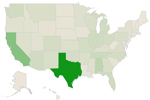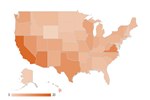Renewable Propane
Renewable propane is an alternative fuel made from non-petroleum feedstocks such as natural fats, vegetable oils, and various types of grease. It is chemically identical to conventional propane and can be used as a drop-in replacement fuel in all propane applications. Nearly all renewable propane in the United States is used in California, Washington, and Oregon due to incentives from the California Low Carbon Fuel Standard and Washington and Oregon’s Clean Fuel Standard.
Production
Renewable propane is produced predominantly through a hydrotreated vegetable oil process (also known as hydroprocessed esters and fatty acids or HEFA). This is the primary source for commercial-scale renewable propane production, most commonly made with feedstocks such as fat, oil, and grease.
U.S. renewable propane production capacity is more than 4.5 million gallons per year,1 with the largest facilities in California and Louisiana. Renewable propane production could increase alongside growth in the production of renewable diesel and sustainable aviation fuel since renewable propane can be created as a byproduct of producing those fuels.

Benefits
The primary benefit of renewable propane is its carbon intensity, which can be four times lower than the carbon intensity of conventional propane, according to the Propane Education & Research Council. The actual carbon reduction benefit depends on the feedstock used to produce the fuel. In addition to a significant reduction in carbon intensity, criteria pollutant emissions are comparable to conventional propane since the fuels are chemically identical.
Research and Development
Research continues to seek methods to overcome barriers to renewable propane scale-up and demonstration, including feedstock and production cost challenges.
More Information
Learn more about renewable propane from the links below. The Alternative Fuels Data Center (AFDC) and U.S. Department of Energy do not necessarily recommend or endorse these organizations (see disclaimer).
1 This number is based on EPA Renewable Identification Number (RIN) transaction data available for public consumption. Actual retail volumes of renewable propane are higher as renewable propane derived from certain feedstocks (e.g., pure soybean oil) do not qualify for EPA RIN credits and hence are not tracked by the EPA.



